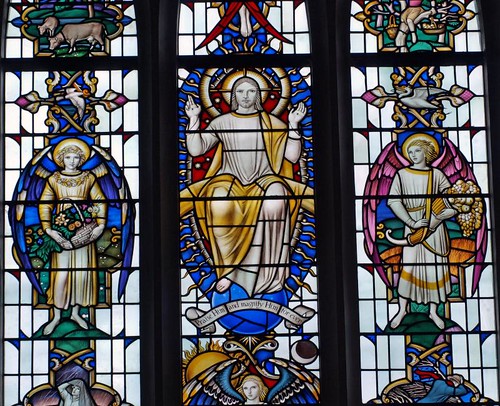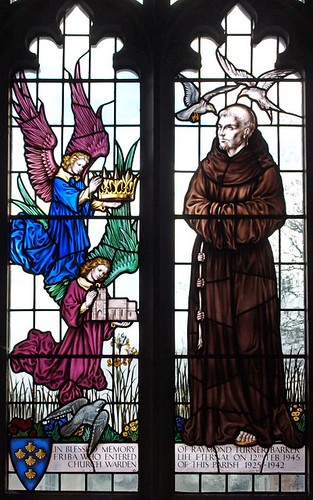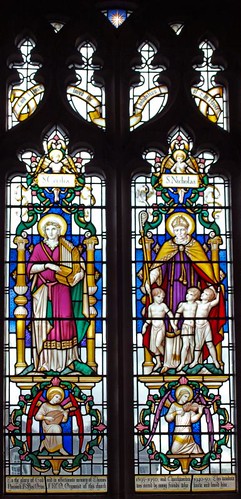ST MARY. The exterior is too drastically restored to have preserved any of its original character. The SW tower, nave, clerestory, N aisle (with its odd N gable), S aisle wall, and S chancel chapel were newly built in the 1910. Inside, the chancel has a long lancet window in the S wall and two blocked ones in the N wall. The E end has a group of three stepped-up lancets, with Purbeck marble shafts inside. The Double Piscina has pointed trefoil heads. The chancel arch is double-chamfered on broadly moulded capitals. The forms of these and the arches are repeated in the S arcade of four bays. - SCREEN and COMMUNION RAIL destroyed by fire in 1952. - PLATE. Chalice, 1666; Paten, 1678; Flagon, 1750. - MONUMENT. Edward Young, author of Night Thoughts and On Original Composition, who was Vicar of Welwyn from 1730 to 1765.
Welwyn. Within a mile of new Welwyn, the garden city of 20th-century colonists, lies this old Welwyn where the Roman colonists settled, probably with a temple where the church now stands on the edge of the Maran valley. Roman tiles have appeared in the churchyard; Roman bricks are in the church walls; but most of the church has been made new. There is a bit of a Norman capital in the vestry walls, and some medieval heads are preserved in the aisle. One of the arcades is 13th century, and from the 15th come two plain roofs, the screen with elaborate tracery and finials, and the porch approached by a grand yew hedge. The piscina is 700 years old.
Under the altar Edward Young was buried in 1765. On the wall is a tablet to this poet, who was rector for 35 years and planted the rectory’s fine avenue of limes. Dr Johnson much admired his Night Thoughts, and admired also these lime trees when he called here at the invitation of the poet’s son, an invitation manoeuvred by Boswell, who went on ahead leaving Dr Johnson sipping tea at the inn quite ignorant of his friend’s intention. Boswell came back with the invitation, and Johnson greeted the poet’s son with a very polite bow, saying: “Sir, I had a curiosity to come and see this place; I had the honour to know that great man your father.” They sat and talked in the rectory summerhouse, and we may think that Johnson would recall that much-quoted epigram of Dr Young on Voltaire:
In the home of Edward Young there lived for 40 years another famous man, Henry Fynes Clinton, one of the most remarkable classical scholars of the 18th century. It is known that he mastered in eight years 33,000 pages of Greek literature and that he read 69,322 verses of poetry. He kept a journal in Latin and Greek till the day before he died. Few men have ever had a more complete knowledge of Greek poets and prose writers; he lived out the Psalmist’s span of life and gave nearly every day of it to scholarship. He lies in a village graveyard in Nottinghamshire.
The rectors of Welwyn are also the lords of the manor, for the manor was given to the church by Edward the Confessor.
The graves of Romans buried here centuries before the Confessor’s day have yielded many interesting objects, including glass decanters and a tiny clay statue of a lady of the 1st century. Older finds from the park of Lockleys form a striking group in the Iron Age Gallery of the British Museum. They include an iron frame 42 inches high which may have served as a sacrificial altar, three pairs of fire-dogs ending in fantastic animal heads, and five huge jars for wine or oil. Other finds were some silver cups and bronze vessels, and three bronze masks marked with moustache and hair. They appear to have been imported from the Mediterranean about the time Julius Caesar first invaded Britain, when his raiders reached the neighbourhood of St Albans, where a critical battle was fought. Half a mile outside Welwyn is Lockleys, a handsome brick-built mansion erected in 1717.
Under the altar Edward Young was buried in 1765. On the wall is a tablet to this poet, who was rector for 35 years and planted the rectory’s fine avenue of limes. Dr Johnson much admired his Night Thoughts, and admired also these lime trees when he called here at the invitation of the poet’s son, an invitation manoeuvred by Boswell, who went on ahead leaving Dr Johnson sipping tea at the inn quite ignorant of his friend’s intention. Boswell came back with the invitation, and Johnson greeted the poet’s son with a very polite bow, saying: “Sir, I had a curiosity to come and see this place; I had the honour to know that great man your father.” They sat and talked in the rectory summerhouse, and we may think that Johnson would recall that much-quoted epigram of Dr Young on Voltaire:
Thou art so witty, profligate, and thin,
At once we think thee Milton, Death, and Sin.
In the home of Edward Young there lived for 40 years another famous man, Henry Fynes Clinton, one of the most remarkable classical scholars of the 18th century. It is known that he mastered in eight years 33,000 pages of Greek literature and that he read 69,322 verses of poetry. He kept a journal in Latin and Greek till the day before he died. Few men have ever had a more complete knowledge of Greek poets and prose writers; he lived out the Psalmist’s span of life and gave nearly every day of it to scholarship. He lies in a village graveyard in Nottinghamshire.
The rectors of Welwyn are also the lords of the manor, for the manor was given to the church by Edward the Confessor.
The graves of Romans buried here centuries before the Confessor’s day have yielded many interesting objects, including glass decanters and a tiny clay statue of a lady of the 1st century. Older finds from the park of Lockleys form a striking group in the Iron Age Gallery of the British Museum. They include an iron frame 42 inches high which may have served as a sacrificial altar, three pairs of fire-dogs ending in fantastic animal heads, and five huge jars for wine or oil. Other finds were some silver cups and bronze vessels, and three bronze masks marked with moustache and hair. They appear to have been imported from the Mediterranean about the time Julius Caesar first invaded Britain, when his raiders reached the neighbourhood of St Albans, where a critical battle was fought. Half a mile outside Welwyn is Lockleys, a handsome brick-built mansion erected in 1717.



No comments:
Post a Comment